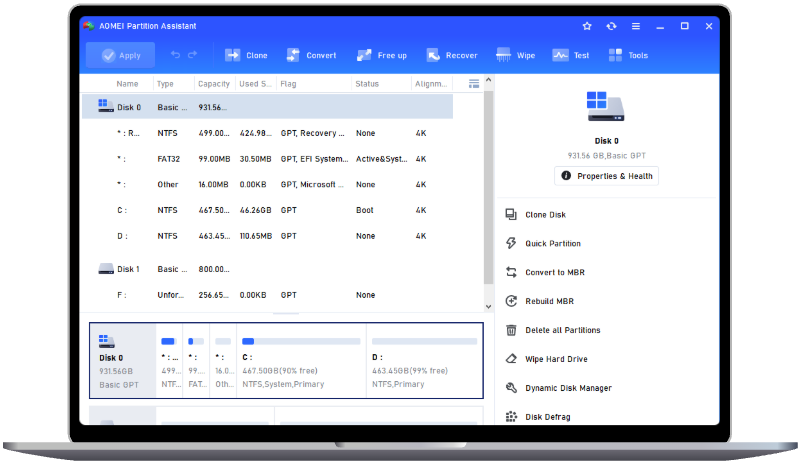How to Fix Memory Management Stop Codeon Windows [9 Ways]
The "Memory ManagementStop Code" is a BSOD error that occurs on Windows PCs. While it is a critical system error that can cause significant damage to your computer, it can be easily fixed using the 9 methods outlined in this article.
What is the Memory Management Stop Code?
The Memory Management Stop Code is a type of Blue Screen of Death (BSOD) error in Windows. It typically occurs when there is a problem with the computer’s memory, either the physical RAM or virtual memory. When this stop code appears, it indicates that Windows has detected an issue that prevents the operating system from functioning properly, especially with regard to handling memory.
The error code usually appears as:
*** STOP: 0x0000001A (0x0000000000041790, 0xFFFFE00004C00000, 0x0000000000000000, 0x0000000000000000)
Causes of the Memory Management Stop Code:
✦ Faulty RAM: Bad or failing physical memory (RAM) can trigger this error. This is often due to hardware issues or aging components.
✦ Corrupted system files: Damaged system files, like Windows kernel or memory management files, can lead to improper memory management and result in this BSOD.
✦ Outdated drivers: Sometimes, outdated or incompatible drivers, especially graphics or storage drivers, can cause the operating system to fail when managing memory.
✦ Software conflicts: Certain applications or third-party programs, particularly those related to system utilities or security software, may conflict with Windows memory management processes.
✦ Corrupt virtual memory/page file: If the virtual memory or paging file (where Windows uses disk space to simulate RAM) is corrupt or improperly configured, it can result in memory management errors.
✦ Overclocking: Overclocking the system’s RAM or CPU can sometimes lead to instability, including memory-related errors.
How to fix the Memory Management Stop Code in Windows
Fixing the "Stop Code Memory Management" error on Windows is essential as soon as it appears. If you're unsure how to resolve it, there's no need to worry. We have a comprehensive guide to help you. Before diving into the solutions, make sure to back up your data and ensure your system's security is up to date.
Method 1. Restart your computer
Rebooting your Windows PC is often a simple yet effective way to resolve the "Stop Code Memory Management" issue. Windows is designed to handle various problems automatically, and restarting can clear up minor glitches.
Step 1. Click the Start menu icon located at the bottom-left corner of your screen.
Step 2. Select the Power button at the bottom of the Start menu.
Step 3. From the options provided, choose Restart.
Method 2. Run Windows Memory Diagnostic Tool
Running the Memory Diagnostic tool can help identify any issues with your computer's RAM. It's particularly useful if you suspect your memory might be faulty.
Step 1. Press Windows Key + R, type "mdsched.exe" in the Run dialog, and hit Enter.
Step 2. In the pop-up window, select "Restart now and check for problems (recommended)".
Step 3. The tool will begin the scan, and you'll see progress and test passes displayed on the screen.
Method 3. Update drivers
While Windows 11 and 10 typically manage driver updates automatically, there are times when manual updates are necessary. Outdated drivers are a common cause of BSOD errors. Follow these steps to update your drivers:
Step 1. Right-click the Start button and select Device Manager.
Step 2. Scroll through the list and look for any components with error symbols.
Step 3. Click the arrow next to the faulty component to expand it.
Step 4. Right-click the driver listed and select Update Driver.
Step 5. Select the “Search automatically for drivers” option. Please wait patiently.
Method 4. Check for Windows Updates
Outdated Windows versions are a common cause of the "Memory Management Stop Code" error. If your system hasn't been updated in a while, the issue you're encountering might be linked to this. To check for updates:
Step 1. Press the Windows key + I to open the Settings menu.
Step 2. Navigate to Update & Security.
Step 3. Under Windows Update, look for any pending updates.
Step 4. Click on Install now to begin downloading and installing the update.
Step 5. Allow the update process to complete, save any unsaved work, and then click Restart Now.
Method 5. Scan and repair corrupt system files (SFC & DISM)
The System File Checker tool helps repair corrupt or missing system files, which can lead to the MEMORY MANAGEMENT BSOD error. Running this tool can fix the issue.
Step 1. Press Windows Key + S to open the search bar, type "CMD", and select Run as Administrator.
Step 2. In the Command Prompt window, enter the following commands one by one:
DISM /online /cleanup-image /restorehealth
sfc /scannow
Method 6. Run a full malware scan
Viruses or malware can cause system crashes and blue screens. To eliminate any harmful programs, it's crucial to run a full system scan using Windows Security or another antivirus program.
Step 1. Open the Windows Security app on your PC.
Step 2. Click on Virus & Threat Protection and select Scan Options to choose the type of scan.
Step 3. Choose Full Scan from the available options, then click the Scan Now button to begin. The scan will detect and address any potential threats.
Method 7. Check for hard drive issues
Corrupt system files can trigger the "Memory Management Stop CodeWindows 11" error. The chkdsk command scans and repairs these files. Here's how to use it:
Step 1. Type Command Prompt in the search box and select Run as Administrator.
Step 2. Type chkdsk C: /f /r and press Enter.
Step 3. Allow the process to complete. The CHKDSK utility will automatically scan and repair any system-related issues.
Method 8. Run a boot repair tool
Experiencing frequent Memory Management Stop Code errors can be both frustrating and disruptive. These issues often arise due to corrupted boot files, a damaged Master Boot Record (MBR), or problems within the Boot Configuration Data (BCD). Fortunately, a reliable and user-friendly solution exists—AOMEI Partition Assistant.
With its "Boot Repair" feature, AOMEI Partition Assistant is designed to tackle critical boot failures. Whether your computer is stuck in a boot loop, fails to start properly, or continuously crashes with BSOD errors, this tool can efficiently repair boot files and restore normal system functionality.
Step 1. Download and install AOMEI Partition Assistant on a functional PC, then connect a USB drive to it.
Step 2. Select Recover > Boot Repair from the main interface.
Step 3. Choose the create a bootable disk option to generate WinPE bootable media.
Step 4. Connect the drive to the malfunctioning computer and try to start it. Once you log in successfully, it will automatically load the Boot Repair tool and initiate the boot entries scanning process.
Step 5. Once the process completes, all boot entries will be displayed. Select the entries that you want to repair and click the Repair button.
Step 6. After the repair is successful, remove the bootable USB drive and reboot the PC from the original system drive.
Method 9. Reset or reinstall Windows
Resetting Windows is a last-resort solution for fixing the "Stop Code Memory Management" error if all other methods fail. This process replaces existing system files with fresh ones, helping to resolve memory management errors and prevent future issues caused by file corruption or malfunction. Here's how to reset your Windows 10/11:
Step 1. Click the Start button, then go to Settings > Update & Security.
Step 2. Select Recovery from the left pane.
Step 3. Under the Reset this PC section, click Get Started.
Step 4. After restarting, you'll be presented with two options: Keep my files or Remove everything. Choose the option that best suits your needs.
Step 5. Allow the process to complete, then check if the memory management error is resolved.
Conclusion
Fixing the "Memory ManagementStop Code" error in Windows has become a simpler task with various solutions available. We’ve outlined the potential causes and provided detailed steps to resolve this frustrating issue. Additionally, using a professional boot repair tool like AOMEI Partition Assistant can be a valuable tool in the process.


